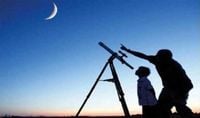The upcoming lunar crescent observation on March 29, 2025, is generating significant anticipation within the Muslim community, as it marks the potential start of the month of Shawwâl and the celebration of Aïd Al Fitr. However, a report from the National Institute of Meteorology indicates that the crescent will not be visible in any Arab or Muslim country after sunset on that day due to its proximity to the Sun.
According to the report, the crescent will be so close to the Sun that its visibility will be severely hindered. The observation of the crescent will only be possible starting on Sunday, March 30, 2025, at 01:14 (Tunisian time), beginning with the center of North America and progressively moving westward.
On March 29, a central conjunction between the Sun and the Moon, also known as a new moon, will occur at 11:58 (Tunisian time). This event will coincide with a partial solar eclipse, which will be visible across regions including North Africa, North America, Europe, and North Asia. The eclipse is expected to reach an occultation rate of 0.93818, meaning that approximately 94% of the solar disk will be obscured by the Moon at the peak of the eclipse.
In Tunisia, the Moon will remain above the horizon for about 15 to 17 minutes after sunset on March 29, providing a brief window for potential observation. Specifically, in Jendouba, the Moon will reach its highest point above the horizon at approximately 2.35 degrees, with an angular distance of about 4.23 degrees from the Sun. In contrast, Casablanca will see the Moon for a maximum of 20 minutes, reaching a height of 2.95 degrees and an arc of about 4.84 degrees.
As the Muslim community eagerly awaits the announcement of Aïd Al Fitr, many are turning to traditional methods of lunar observation to determine the date. This year, the significance of March 29 is heightened by what is referred to as the "night of doubt," a term used to describe the uncertainty surrounding the sighting of the crescent.
Saudi News FR will be actively covering the events in Saudi Arabia, where observers will be stationed at various centers to witness the crescent's appearance. The official announcement regarding the date of Aïd Al Fitr will be made later that day, according to the Saudi time zone.
While some groups advocate for using fixed astronomical calculations to determine the date of the holiday, the Sunni Muslim tradition emphasizes visual observation of the lunar crescent. This approach has led to differing opinions within the community, with some individuals calling for adherence to traditional methods despite the availability of scientific calculations.
Badr Al-Omaira, a notable figure in the discussion on lunar observations, has indicated that the crescent will likely not be visible on March 29 due to the solar eclipse. He suggests that Aïd Al Fitr may therefore be observed on Monday, March 31, 2025, as the determination of fasting relies on visible sightings rather than astronomical calculations.
As the community prepares for this significant date, many are encouraged to stay informed through platforms like Ajib.fr, which will provide live updates and coverage of the lunar crescent sighting and the subsequent announcement regarding Aïd Al Fitr.
The anticipation surrounding Aïd Al Fitr is not only a matter of religious observance but also a reflection of the diverse practices within the Muslim community. As various regions may adopt different dates based on local sightings, the importance of unity and shared celebration remains a focal point.
In light of the impending lunar events, many are reminded of the importance of maintaining traditions while also navigating the complexities introduced by modern technology and scientific understanding. The upcoming days will be crucial as they culminate in the potential celebration of Aïd Al Fitr, a time of joy, community, and reflection.
As March 29 approaches, the Muslim community worldwide remains hopeful for a clear sighting of the lunar crescent, which will herald the beginning of Shawwâl and the joyous occasion of Aïd Al Fitr. The blend of tradition and modern observation methods will undoubtedly shape the celebrations, as families and friends come together to mark this important time in the Islamic calendar.






